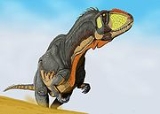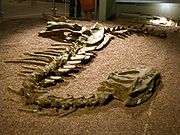
Yangchuanosaurus
Encyclopedia
Yangchuanosaurus was a theropod dinosaur
that lived in China
during the late Oxfordian (and possibly Kimmeridgian
) stage of the Late Jurassic
, and was similar in size and appearance to its North America
n contemporary, Allosaurus
. It hails from the Upper Shaximiao Formation and was the largest predator in a landscape which included the sauropods Mamenchisaurus
and Omeisaurus
as well as the Stegosaurs
Chialingosaurus
, Tuojiangosaurus
and Chungkingosaurus
 The type specimen
The type specimen
of Y. shangyouensis had a skull
82 cm (2.7 ft) long, and its total body length was estimated at about 8 m (26.2 ft). Another specimen, assigned to the new species Y. magnus, was even larger, with a skull length of 1.11 m (3.6 ft). It may have been up to 10.8 m (35.4 ft) long, and weighed as much as 3.4 metric tons (3.7 ST). There was a bony knob on its nose and multiple hornlets and ridges, similar to Ceratosaurus
.
It had a massive tail that was about half its length.
 In June 1977, an almost complete skeleton
In June 1977, an almost complete skeleton
of what was to be named Yangchuanosaurus shangyouensis was uncovered by a construction worker during the construction of the Shangyou Reservoir Dam in the Yongchuan District
. Since then further skeletons have been recovered.
Gregory S. Paul (1988) regarded this genus as the same as Metriacanthosaurus
, but this has not been supported.
Dinosaur
Dinosaurs are a diverse group of animals of the clade and superorder Dinosauria. They were the dominant terrestrial vertebrates for over 160 million years, from the late Triassic period until the end of the Cretaceous , when the Cretaceous–Paleogene extinction event led to the extinction of...
that lived in China
People's Republic of China
China , officially the People's Republic of China , is the most populous country in the world, with over 1.3 billion citizens. Located in East Asia, the country covers approximately 9.6 million square kilometres...
during the late Oxfordian (and possibly Kimmeridgian
Kimmeridgian
In the geologic timescale, the Kimmeridgian is an age or stage in the Late or Upper Jurassic epoch or series. It spans the time between 155.7 ± 4 Ma and 150.8 ± 4 Ma . The Kimmeridgian follows the Oxfordian and precedes the Tithonian....
) stage of the Late Jurassic
Late Jurassic
The Late Jurassic is the third epoch of the Jurassic Period, and it spans the geologic time from 161.2 ± 4.0 to 145.5 ± 4.0 million years ago , which is preserved in Upper Jurassic strata. In European lithostratigraphy, the name "Malm" indicates rocks of Late Jurassic age...
, and was similar in size and appearance to its North America
North America
North America is a continent wholly within the Northern Hemisphere and almost wholly within the Western Hemisphere. It is also considered a northern subcontinent of the Americas...
n contemporary, Allosaurus
Allosaurus
Allosaurus is a genus of large theropod dinosaur that lived 155 to 150 million years ago during the late Jurassic period . The name Allosaurus means "different lizard". It is derived from the Greek /allos and /sauros...
. It hails from the Upper Shaximiao Formation and was the largest predator in a landscape which included the sauropods Mamenchisaurus
Mamenchisaurus
Mamenchisaurus was a plant-eating four-legged dinosaur, known for its remarkably long neck which made up half its total length. It is known from numerous species which ranged in time from 160 to 145 million years ago, from the Oxfordian to Tithonian ages of the late Jurassic Period of...
and Omeisaurus
Omeisaurus
Omeisaurus is a genus of sauropod dinosaur from the Middle Jurassic Period of what is now China. Its name comes from Mount Emei, where it was discovered in the lower Shaximiao Formation of Sichuan Province.Like other sauropods, Omeisaurus was herbivorous and large...
as well as the Stegosaurs
Stegosauria
Known colloquially as stegosaurs, the Stegosauria are a group of herbivorous dinosaurs of the Jurassic and Early Cretaceous Periods, being found mostly in the Northern Hemisphere, predominantly in what is now North America and China....
Chialingosaurus
Chialingosaurus
Chialingosaurus is a genus of stegosaur similar to Kentrosaurus from the Upper Shaximiao Formation, Late Jurassic beds in Sichuan Province in China. Its age makes it one of the oldest species of stegosaurs, living about 160 million years ago...
, Tuojiangosaurus
Tuojiangosaurus
Tuojiangosaurus is a genus of stegosaurid dinosaur from the Late Jurassic Period, recovered from the Upper Shaximiao Formation of what is now Sichuan Province in China. Physically similar to the North American Stegosaurus, Tuojiangosaurus is the best understood of the Chinese stegosaurids...
and Chungkingosaurus
Chungkingosaurus
Chungkingosaurus, meaning "Chongqing Lizard", is a genus of dinosaur from the Late Jurassic-age Upper Shaximiao Formation in what is now China. It is classified as a stegosaurid.-Discovery and species:...
Description

Biological type
In biology, a type is one particular specimen of an organism to which the scientific name of that organism is formally attached...
of Y. shangyouensis had a skull
Skull
The skull is a bony structure in the head of many animals that supports the structures of the face and forms a cavity for the brain.The skull is composed of two parts: the cranium and the mandible. A skull without a mandible is only a cranium. Animals that have skulls are called craniates...
82 cm (2.7 ft) long, and its total body length was estimated at about 8 m (26.2 ft). Another specimen, assigned to the new species Y. magnus, was even larger, with a skull length of 1.11 m (3.6 ft). It may have been up to 10.8 m (35.4 ft) long, and weighed as much as 3.4 metric tons (3.7 ST). There was a bony knob on its nose and multiple hornlets and ridges, similar to Ceratosaurus
Ceratosaurus
Ceratosaurus meaning "horned lizard", in reference to the horn on its nose , was a large predatory theropod dinosaur from the Late Jurassic Period , found in the Morrison Formation of North America, in Tanzania and Portugal...
.
It had a massive tail that was about half its length.
Discovery and species

Skeleton
The skeleton is the body part that forms the supporting structure of an organism. There are two different skeletal types: the exoskeleton, which is the stable outer shell of an organism, and the endoskeleton, which forms the support structure inside the body.In a figurative sense, skeleton can...
of what was to be named Yangchuanosaurus shangyouensis was uncovered by a construction worker during the construction of the Shangyou Reservoir Dam in the Yongchuan District
Yongchuan District
Yongchuan is a district of Chongqing, China, located by the north side of upper reach of Yangtze river,with a history of 1200 years. Yongchuan is 63 km away from Yuzhong of Chongqing city and 276 km from Chengdu.-Administration:...
. Since then further skeletons have been recovered.
Gregory S. Paul (1988) regarded this genus as the same as Metriacanthosaurus
Metriacanthosaurus
Metriacanthosaurus is a genus of sinraptorid dinosaur from the upper Oxford Clay of England, dating to the mid-Jurassic Period, about 160 million years ago ....
, but this has not been supported.
Museum exhibitions
- The original skeleton of Yangchuanosaurus shangyouensis is on display at the Municipal Museum of ChongqingChongqingChongqing is a major city in Southwest China and one of the five national central cities of China. Administratively, it is one of the PRC's four direct-controlled municipalities , and the only such municipality in inland China.The municipality was created on 14 March 1997, succeeding the...
, as is some material of Y. magnus. Another, recovered from Xuanhan County in Sichuan, is on display in the Beijing Museum of Natural History.
- A cast skeleton of Yangchuanosaurus shangyouensis is on display at DinopolisDinopolisDinopolis, located in Teruel, Spain, is one of the largest museums of paleontology in the world. It also includes some attractions, restaurants and shows...
, in TeruelTeruelTeruel is a town in Aragon, eastern Spain, and the capital of Teruel Province. It has a population of 34,240 in 2006 making it one of the least populated provincial capitals in the country...
, SpainSpainSpain , officially the Kingdom of Spain languages]] under the European Charter for Regional or Minority Languages. In each of these, Spain's official name is as follows:;;;;;;), is a country and member state of the European Union located in southwestern Europe on the Iberian Peninsula...
.

